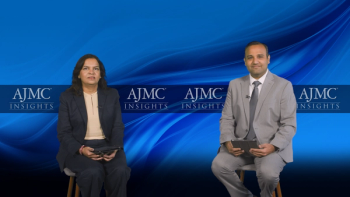
From IV to Oral: Reshaping AML Treatment Access and Disease Burden
A panelist discusses how the shift from intravenous to oral AML therapies addresses significant quality-of-life concerns by eliminating the burden of spending 7 days per month in clinics for infusions (which can consume nearly half of a patient's remaining 15-month median survival time), while also improving clinic efficiency, though implementation requires careful attention to patient adherence, insurance coverage disparities that may penalize oral medications with higher co-pays, and monitoring for drug interactions.
Episodes in this series

The transition from intravenous (IV) to oral acute myeloid leukemia (AML) therapies represents a crucial evolution in cancer care, driven by both patient preferences and health care system efficiency needs. This shift toward oral medications aims to minimize time spent within health care facilities while maintaining therapeutic effectiveness. However, the transition requires careful consideration of patient monitoring, as oral chemotherapy still carries significant risks and requires supportive care, transfusions, and regular supervision. Once patients achieve remission with stable blood counts, the benefits of reduced clinic visits become particularly apparent, though compliance monitoring and patient education remain essential components of successful oral therapy management.
The time burden associated with traditional IV treatment creates a significant quality-of-life impact for older, unfit AML patients. With median survival around 15 months for patients who cannot undergo transplantation, the requirement for 7 clinic days monthly for azacitidine infusions represents a substantial portion of remaining life. Each clinic visit typically consumes an entire day, including travel, parking, laboratory work, waiting times, and the actual infusion process. Over the course of treatment, this translates to approximately 7 full days monthly spent away from family and personal activities, highlighting the profound benefit of oral alternatives that maximize time spent outside healthcare facilities while allowing more efficient clinic resource allocation for patients with greater immediate needs.
Implementation of oral AML therapies faces several practical challenges that require systematic addressing. Patient selection criteria must prioritize individuals with demonstrated medication compliance and cognitive capacity for self-management. Insurance coverage disparities create significant barriers, as oral medications often carry higher co-pays than intravenous treatments, potentially forcing patients to choose less convenient options due to financial constraints rather than clinical appropriateness. Additionally, oral therapy management requires robust systems for monitoring drug interactions, particularly with common medications like antibiotics and cardiac drugs, necessitating close pharmacist collaboration and comprehensive interaction screening protocols to ensure safe and effective treatment delivery.
Newsletter
Stay ahead of policy, cost, and value—subscribe to AJMC for expert insights at the intersection of clinical care and health economics.






























































